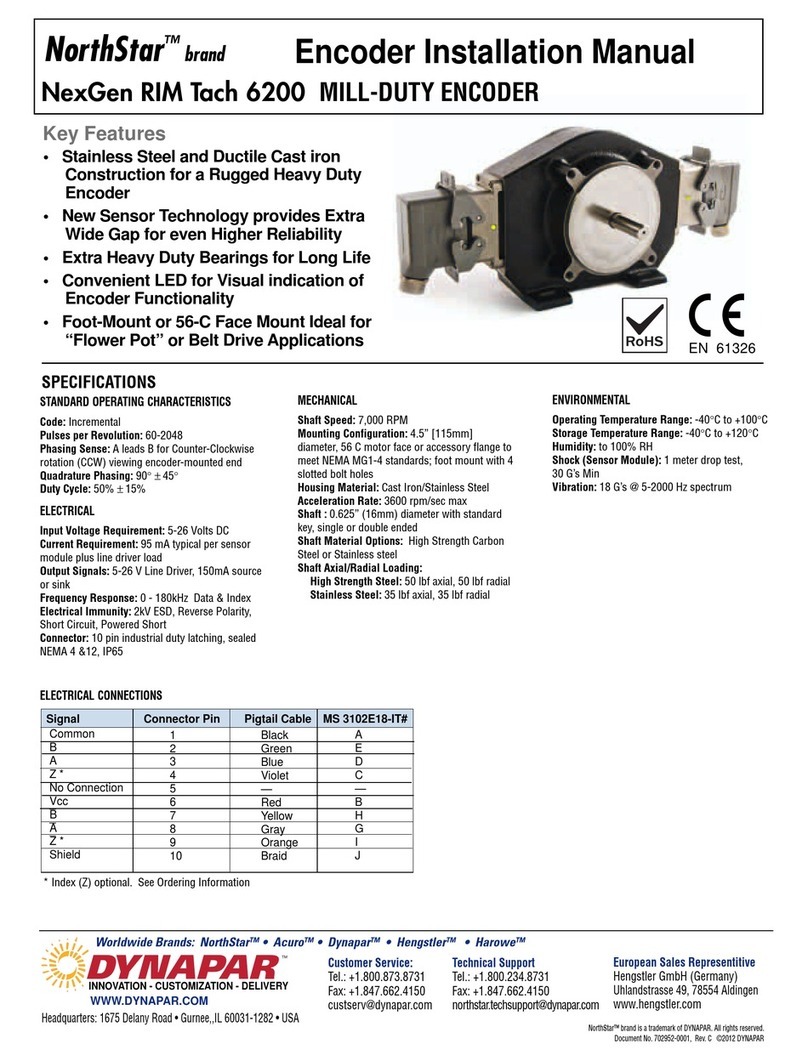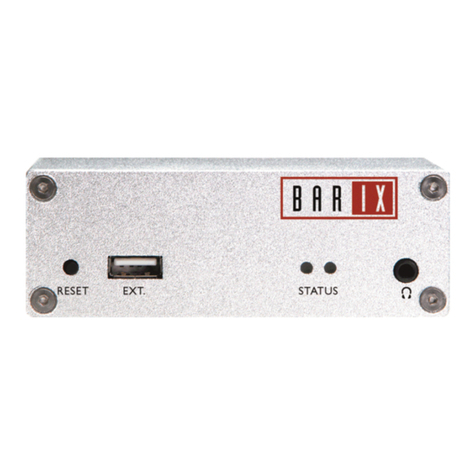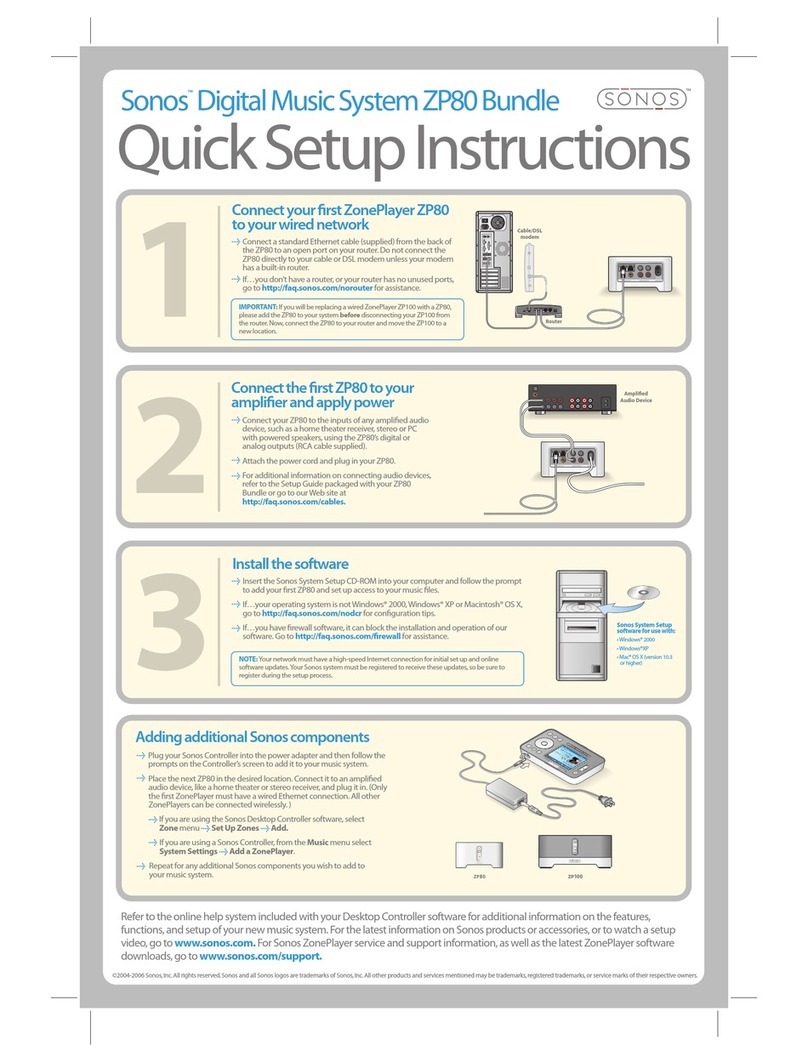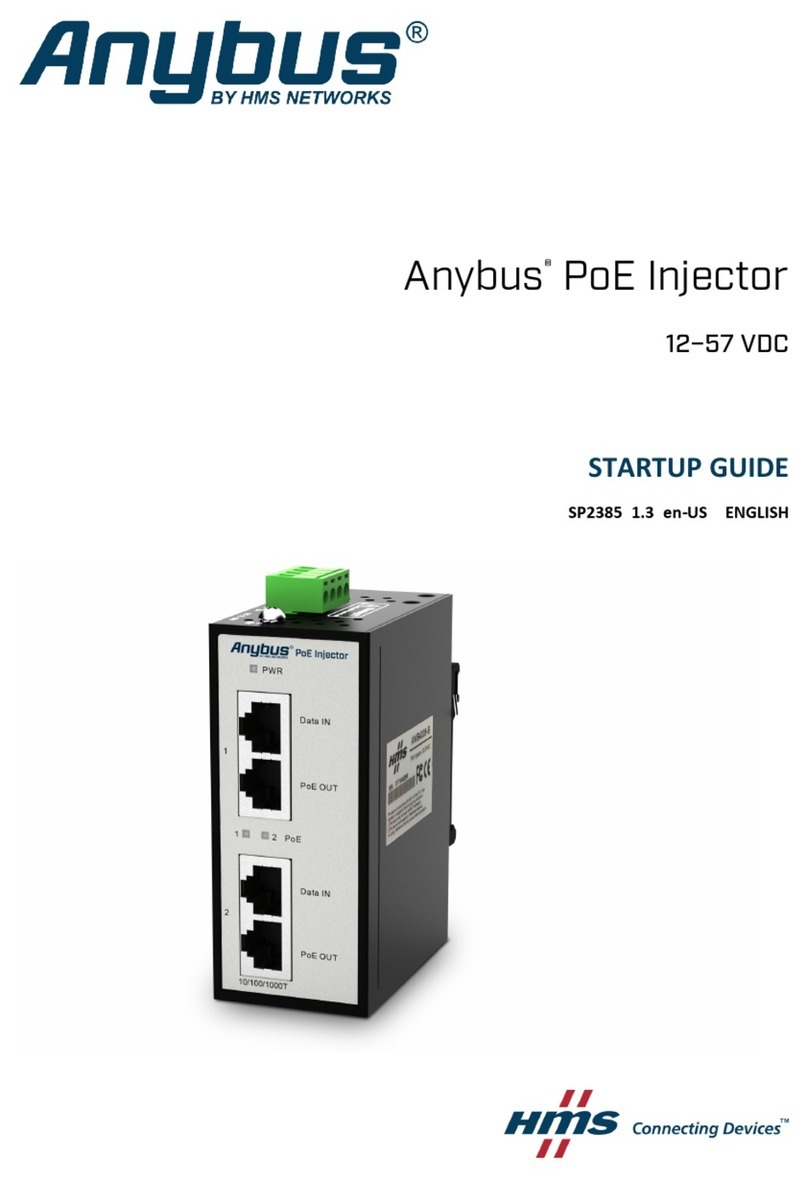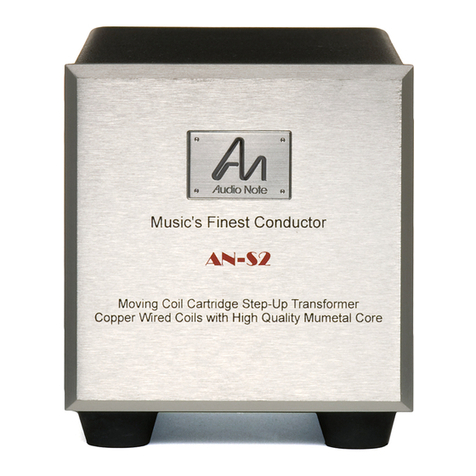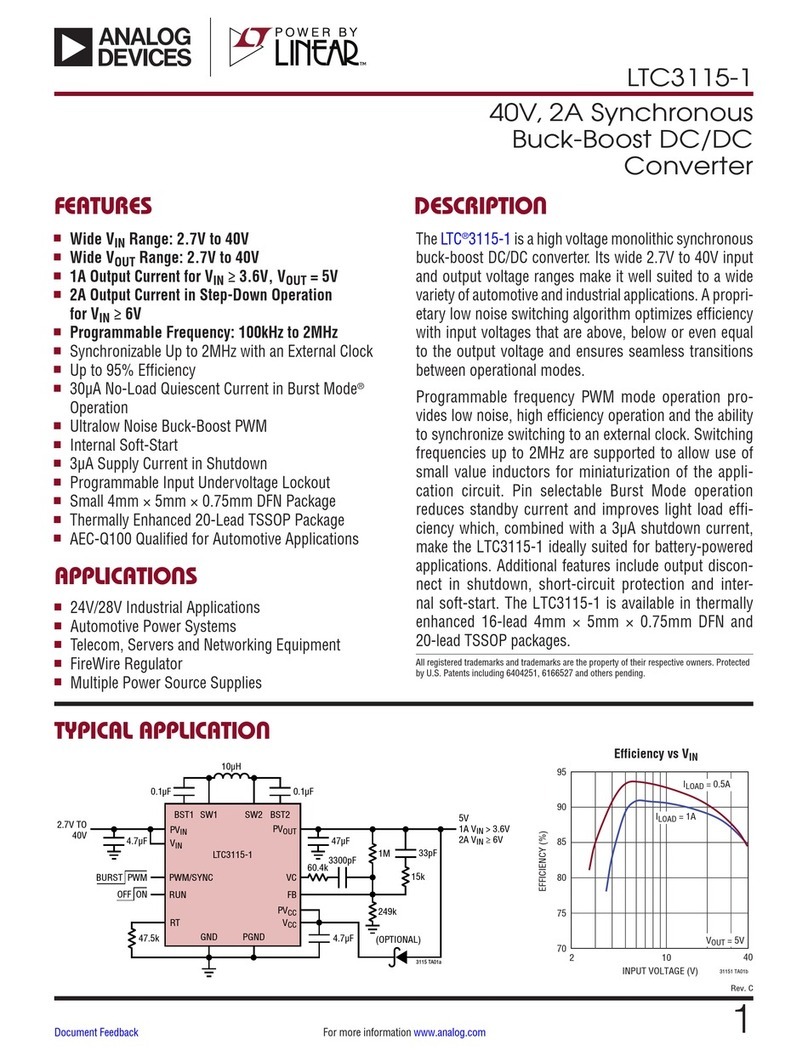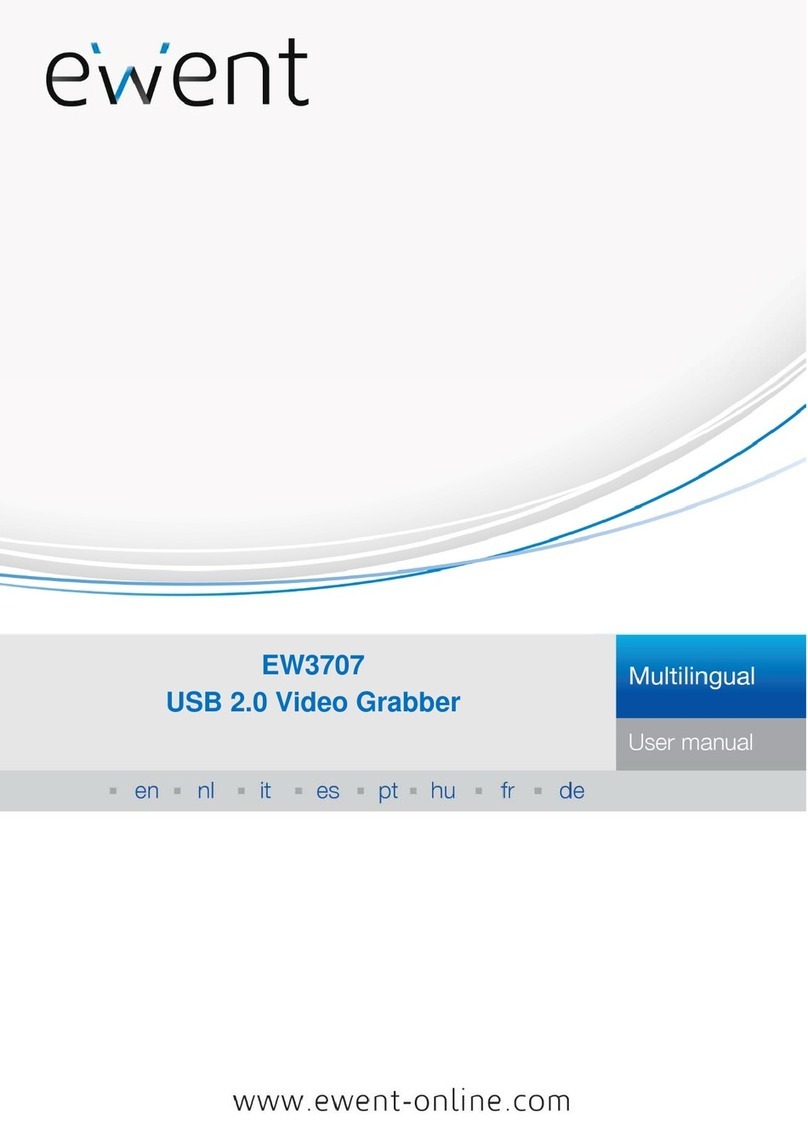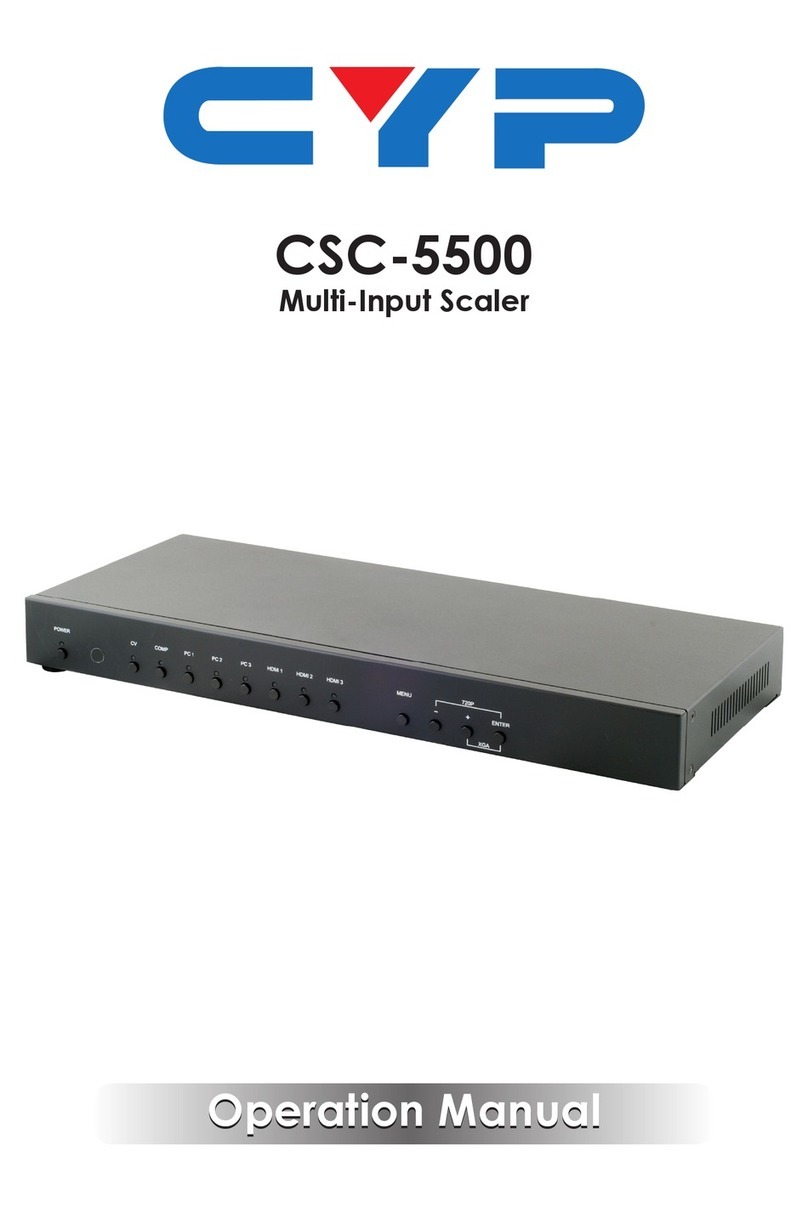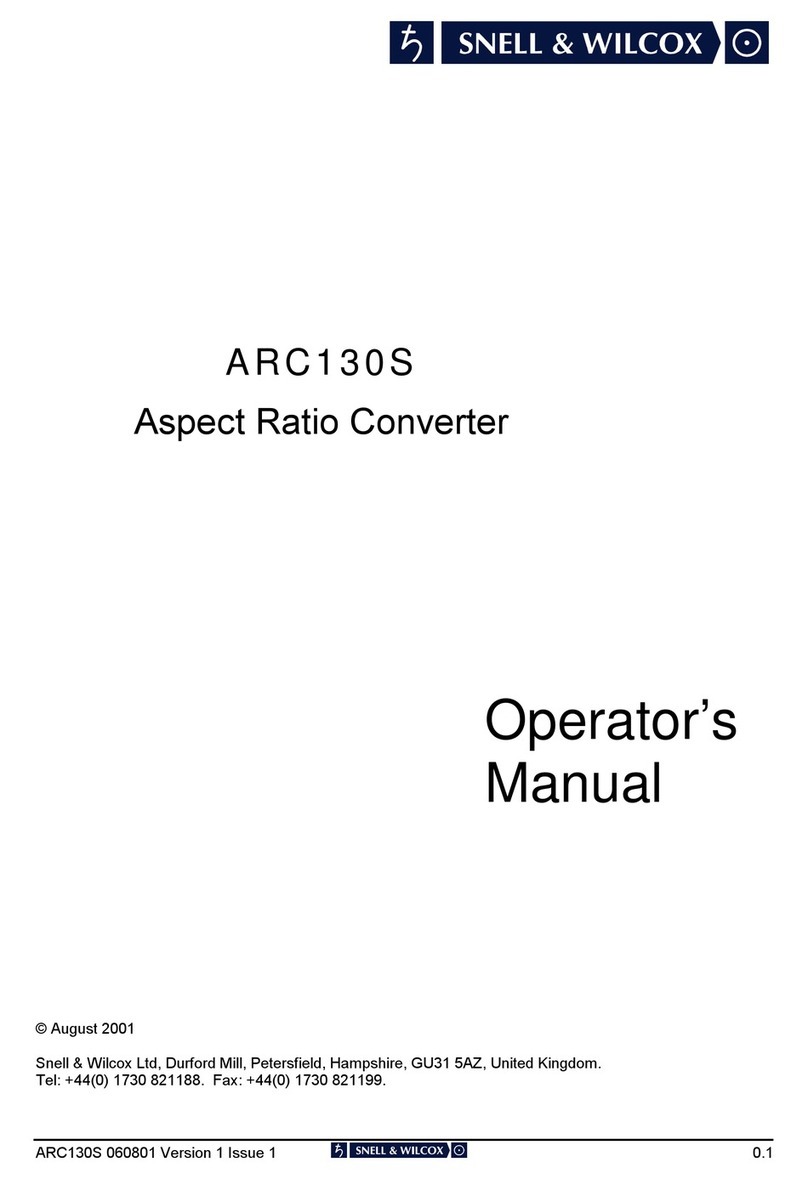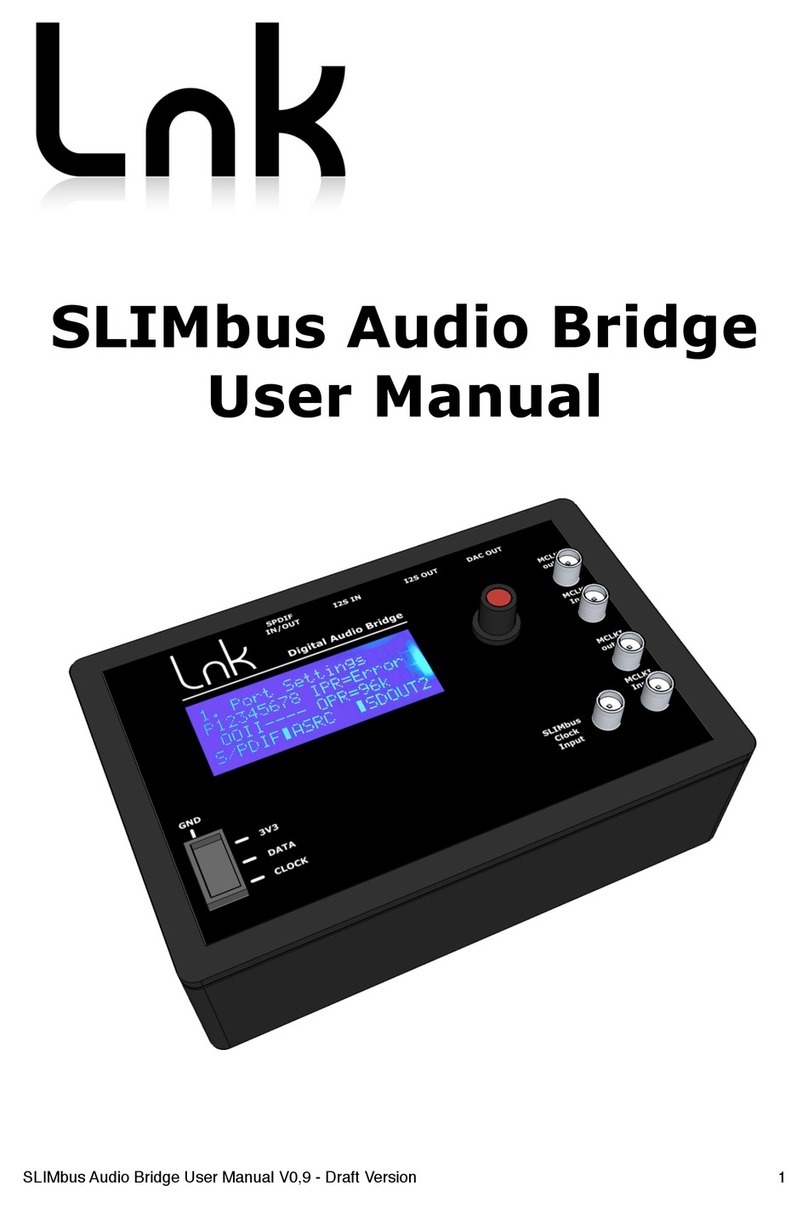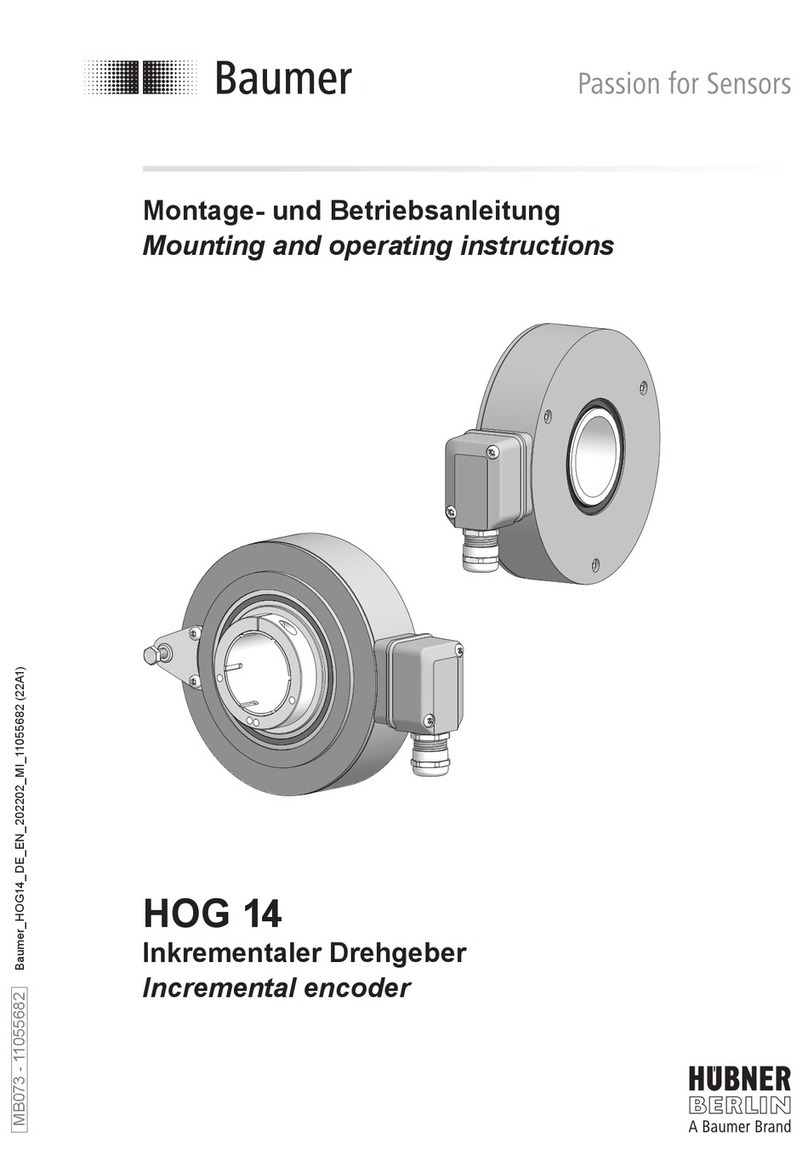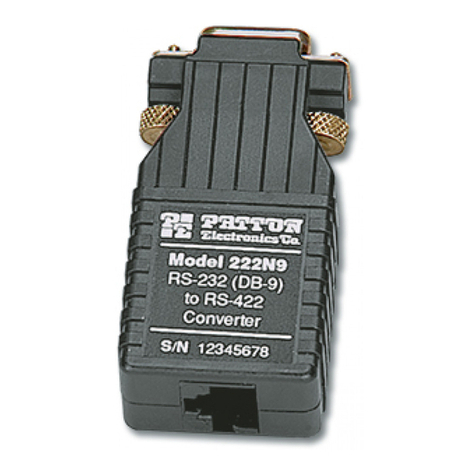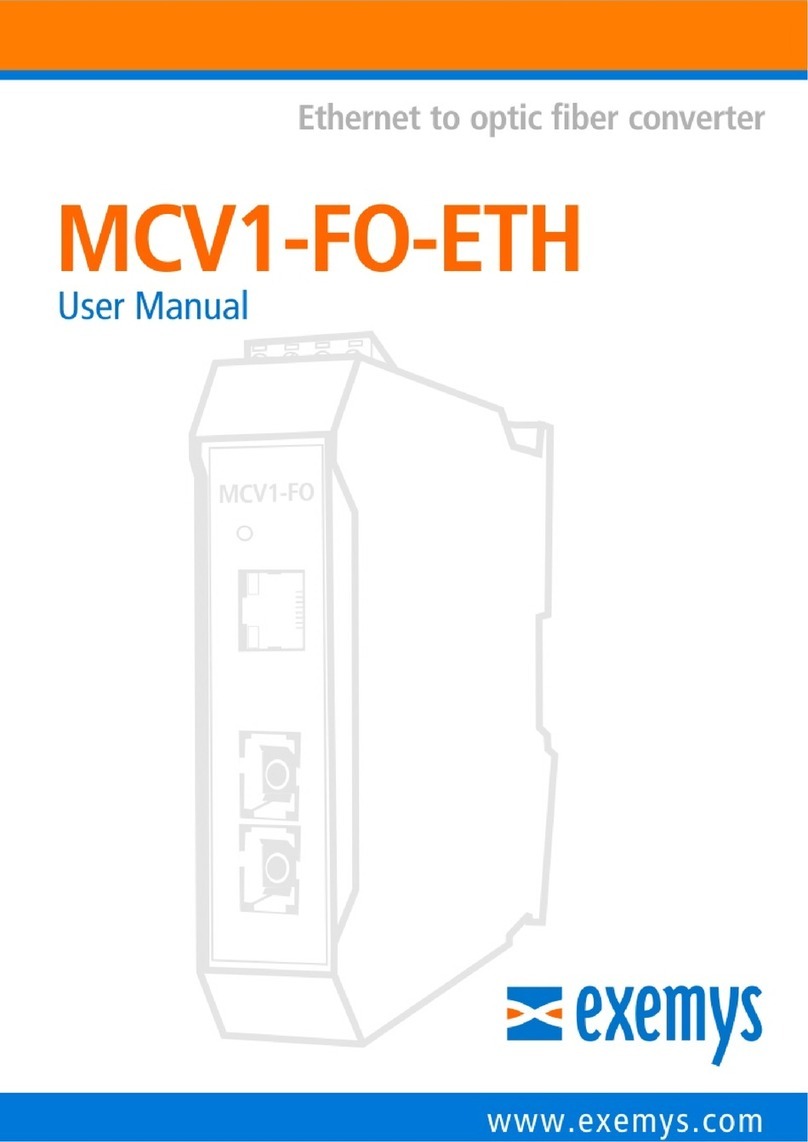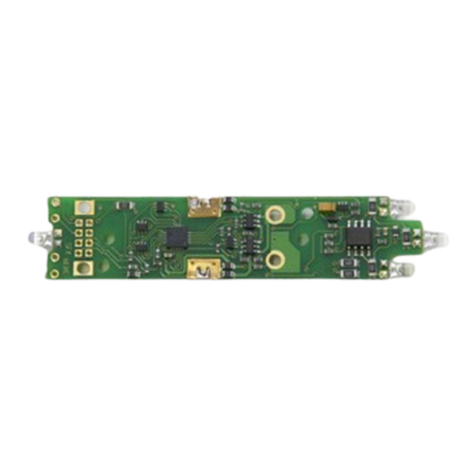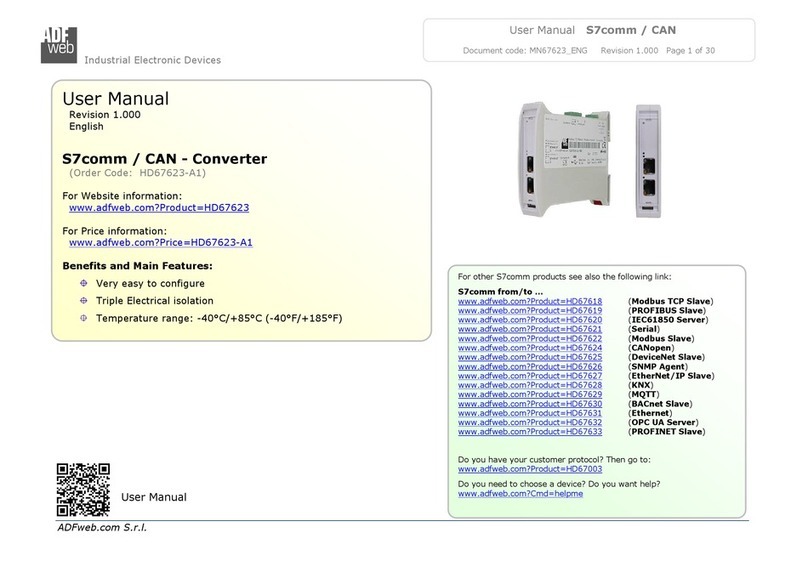WEISS Vesta User manual

Weiss Engineering Ltd.
Florastrasse 42, 8610 Uster, Switzerland
www.weiss-highend.co
VESTA
OWNERS MANUAL

OWNERS MANUAL FOR WEISS VESTA FIREWIRE INTERFACE
Page: 2Date: 10/08 /dw
INTRODUCTION
D
ear
C
usto er
Congratulations on your purchase of the VESTA Firewire Interface and welco e to the fa ily of
Weiss equip ent owners!
The VESTA is the result of an intensive research and develop ent process.
On the following pages I will introduce you to our views on high quality audio processing. These
include funda ental digital and analog audio concepts and the VESTA interface.
I wish you a long-lasting relationship with your VESTA. She won’t let you down.
Yours sincerely,
Daniel Weiss
President, Weiss Engineering Ltd.

OWNERS MANUAL FOR WEISS VESTA FIREWIRE INTERFACE
Page: 3Date: 10/08 /dw
TABLE OF CONTENTS
4 A short history of Weiss Engineering
5 Our ission and product philosophy
6 Advanced digital and analog audio concepts explained
6 Jitter Suppression, Clocking
9 Upsa pling, Oversa pling and Sa pling Rate Conversion in General
11 Reconstruction Filters
12 Analog Output Stages
12 Dithering
14 Firewire vs USB
15 The VESTA Firewire Interface
15 Features
18 Operation / Installation
24 Technical Data
26 Contact

OWNERS MANUAL FOR WEISS VESTA FIREWIRE INTERFACE
Page: 4Date: 10/08 /dw
A SHORT HISTORY OF WEISS ENGINEERING
After studying electrical engineering, Daniel Weiss joined the Willi Studer (Studer - Revox)
co pany in Switzerland. His work included the design of a sa pling frequency converter and of
digital signal processing electronics for digital audio recorders.
In 1985, Mr. Weiss founded the co pany Weiss Engineering Ltd. Fro the outset the co pany
concentrated on the design and anufacture of digital audio equip ent for astering studios. Its
first product was the odular "102 Series" syste . After 23 years, this syste is still up to date
(24 bit / 96kHz) and is still being sold. Hundreds of Mastering Studios around the world use it
every day.
In the early nineties the „Ga bit Series“ was launched, taking ergono ics and sonic quality to new
heights. The „Ga bit Series“consists of stand-alone units like Equalizer, Denoiser / Declicker,
Dyna ics Processor, A/D converter, D/A converter, Sa pling Frequency Converter, Dithering etc.
40 bit floating point processors and sa pling rates up to 96kHz are e ployed.
In 2001 we have decided to enter the High-End Hi-Fi arket which offers a co parable clientele
to that of the Mastering Studios. Both consist of critical and discerning listeners, who are in
constant search for the best audio reproduction equip ent or the best audio tools respectively.
Our list of clients includes big na es, like SONY, BMG, EMI, Warner, Hit Factory, Abbey Road,
Teldec, Telarc, Unitel, Gateway Mastering (Bob Ludwig), Bernie Grund an Mastering, Masterdisk,
Sterling Sound, Whitfield Street, Metropolis and hundreds ore.
For a ore co prehensive list you are invited to visit our pro audio website at www.weiss.ch.

OWNERS MANUAL FOR WEISS VESTA FIREWIRE INTERFACE
Page: 5Date: 10/08 /dw
OUR MISSION AND PRODUCT PHILOSOPHY
The wealth of experience we have gained in over 20 years of designing products for top Mastering
Engineers, we now apply to the design of outstanding High-End Hi-Fi products.
Our ission is to create equip ent which beco es classic right fro the outset; - outstanding in
sonics and design.
Th s ar som of th mil ston s at W iss Engin ring:
1985 Introduction of the "102 Series", a 24 bit odular digital audio processor for Mastering
Studios
1986 Introduction of one of the first sa ple rate converters for digital audio
1987 Introduction of one of the first digital equalizers
1989 Introduction of one of the first digital dyna ics processors
1991 Introduction of the "Ibis" digital ixing console, built for the ix-down of classical usic
1993 Introduction of the "Ga bit" Series of digital audio processors, which e ploy 40 bit floating
point processing and sport an extre ely ergono ic user interface
1995 First 96kHz sa pling rate capable products delivered
2001 Introduction of the MEDEA, our High-End Hi-Fi D/A converter and the first product in our
High-End Series
2004 Introduction of the JASON CD Transport
2007 Introduction of the CASTOR, our High-End Hi-Fi Power A plifier
2008 Introduction of the MINERVA Firewire DAC and the VESTA Firewire – AES/EBU Interface

OWNERS MANUAL FOR WEISS VESTA FIREWIRE INTERFACE
Page: 6Date: 10/08 /dw
ADVANCED DIGITAL AND ANALOG AUDIO CONCEPTS EXPLAINED
Jitt r Suppr ssion and Clocking
What is jitter and how does it affect audio quality? In the audio field the ter jitter designates a
ti ing uncertainty of digital clock signals. E.g. in an Analog to Digital Converter (A/D) the analog
signal is sa pled ( easured) at regular ti e intervals; in the case of a CD, 44100 ti es a second
or every 22.675737.. icroseconds.
If these ti e intervals are not strictly constant then one talks of a jittery conversion clock. In
practice it is of course not possible to generate xactly the sa e ti e interval between each and
every sa ple. After all, even digital signals are analog in their properties and thus are influenced
by noise, crosstalk, power supply fluctuations, te perature etc.
Hence a jittery clock introduces errors to the easure ents taken by the A/D, resulting fro
easure ents being taken at the wrong ti e. One can easily observe that the level of the error
introduced is higher during high audio frequencies, because high frequency signals have a steeper
signal for .
A good designer takes care that the jitter a ount in his/her design is ini ized as well as
possible.
What type of equip ent can be co pro ised by jitter?
There are three types: The A/D Converter as described above, then there is the D/A Converter
where the sa e echanis as in the A/D Converter applies and the third is the Asynchronous
Sa ple Rate Converter (ASRC). The ASRC is not so ething usually found in Hi-Fi syste s. It is
used by Sound Engineers to change the sa ple rate fro e.g. 96kHz to 44.1kHz, or e.g. for
putting a 96kHz recording onto a 44.1kHz CD.
You ay now argue that in High-End Hi-Fi there are such things as „Oversa plers“ or
„Upsa plers“.

OWNERS MANUAL FOR WEISS VESTA FIREWIRE INTERFACE
Page: 7Date: 10/08 /dw
Yes, those are in essence sa pling rate converters, however in a well designed syste these
converters e ploy a synchronous design, where jitter does not play any role. Of course a
conversion between 96kHz and 44.1kHz as in the exa ple above, can be done in a synchronous
anner as well. An ASRC in fact is only required either where one or both of the sa pling
frequencies involved are changing over ti e („varispeed“ ode of digital audio recorders) or where
it is unpractical to synchronize the two sa pling frequencies.
So basically in Hi-Fi jitter atters where there are A/D or D/A converters involved. CD and DVD
players are by far the ost nu erous type of equip ent e ploying D/A converters. And of course
stand-alone D/A converters. Jitter, being an analog quantity, can creep in at various places. The
D/A converter built into CD or DVD players can be „infected“ by jitter through various crosstalk
echanis s, like power supply conta ination by power hungry otors (spindle / servo) or
icrophony of the crystal generating the sa pling clock or capacitive / inductive crosstalk between
clock signals etc.
In the standalone D/A converter jitter can be introduced by inferior cables between the source
(e.g. CD player) and the D/A converter unit or by the sa e echanis s as described above except
for the otors of course.
In the case of a stand-alone D/A converter (as the MINERVA), one has to take two different jitter
conta ination pathes into account.
One is the internal path where internal signals can affect the jitter a ount of the sa pling clock
generator. Here, all the good old analog design principles have to be applied. Such as shielding
fro electric or agnetic fields, good grounding, good power supply decoupling, good signal
trans ission between the clock generator and the actual D/A chip.
The other path is the external signal co ing fro the source to which the sa pling clock has to be
locked. I.e. the D/A converter has to run synchronous to the inco ing digital audio signal and thus
the frequency of the internal sa pling clock generator has to be controlled so that it runs at the
sa e sa pling speed as the source (CD transport). This controlling is done by a Phase Locked
Loop (PLL) which is a control syste with error feedback. Of course the PLL has to be able to follow
the long ter fluctuations of the source, e.g. the sa pling rate of the source will alter slightly over
ti e or over te perature, it will not be a constant 44.1kHz in the case of a CD. But the PLL should
not follow the short ter fluctuations (jitter). Think of the PLL as beeing like a very slow-reacting
fly-wheel.

OWNERS MANUAL FOR WEISS VESTA FIREWIRE INTERFACE
Page: 8Date: 10/08 /dw
Jitter handling in the VESTA in more detail
The Jitter Eli ination Technologies (JET) PLL on the chip used in the VESTA feature state-of-the art
jitter rejection abilities and extre ely low intrinsic jitter levels. Like all phase-locked loops, JET PLL
use feedback to lock an oscillator to a ti ing reference. They track slow reference changes, but
effectively free-run through rapid odulations of the reference (i.e. flywheel like). Fro a jitter
transfer point of view, they provide increasing jitter attenuation above so e chosen corner
frequency.
Jitter attenuation is just one aspect of PLL design. Other considerations include frequency range
and intrinsic jitter. It can be shown that conventional designs are bound by a funda ental tradeoff
between these three aspects. For exa ple, specifying a frequency range of one octave eans using
a low-Q oscillator. But that akes for high intrinsic jitter when the loop corner frequency is held
down. Conversely, good jitter attenuation and low intrinsic jitter can be had by using a voltage-
controlled crystal oscillator (VCXO). But the frequency range is then tiny. A further consideration is
that only low-Q oscillators are easy to integrate on chip. JET PLL sidestep the above- entioned
tradeoff. It incorporates two loops. One is largely or wholly nu eric, and has its corner frequency
set low enough to give good reference-jitter attenuation. The other regulates the analog oscillator
and has its corner frequency set uch higher, to oderate the intrinsic jitter. The two corner
frequencies ight be around 10 Hz and 100 kHz, for exa ple. Another benefit of having a high
corner frequency in the analog loop is that interference, e.g. via the oscillator's supply rail, is ore-
effectively suppressed. JET PLL requires a fast, stable, fixed-frequency clock. It is this that gives it
stability in the band between the two corner frequencies. (Equally, in this band any jitter on this
clock passes straight through to the JET PLL's clock output.) The stable clock is usually derived
fro a free-running crystal oscillator. JET PLL contains a nu ber-controlled oscillator, which can
also be called a fractional frequency divider. Like the analog oscillator, this injects jitter. Typically,
spectru shaping is used to push ost of that jitter up to frequencies where it will be heavily
attenuated by the analog loop. As well as frequency-locking the analog oscillator to the provided
reference, JET PLL can also phase-lock an associated fra e sync to the reference.

OWNERS MANUAL FOR WEISS VESTA FIREWIRE INTERFACE
Page: 9Date: 10/08 /dw
Upsampling, Ov rsampling and Sampling Rat Conv rsion in
G n ral
In consu er audio circles the two ter s oversa pling and upsa pling are in co on use. Both
ter s essentially ean the sa e, a change in the sa pling frequency to higher values.
Upsa pling usually eans the change in sa pling rate using a dedicated algorith (e.g.
i ple ented on a Digital Signal Processor chip (DSP)) ahead of the final D/A conversion (the D/A
chip), while oversa pling eans the change in sa pling rate e ployed in today’s odern D/A
converter chips the selves.
But let’s start at the beginning. What is the sa pling frequency? For any digital storage or
trans ission it is necessary to have ti e discrete sa ples of the signal which has to be processed.
I.e. the analog signal has to be sa pled at discrete ti e intervals and later converted to digital
nu bers. (Also see "Jitter Suppression and Clocking" above)). This sa pling and conversion
process happens in the so called Analog to Digital Converter (A/D). The inverse in the Digital to
Analog Converter (D/A).
A physical law states that in order to represent any given analog signal in the digital do ain, one
has to sa ple that signal with at least twice the frequency of the highest frequency contained in
the analog signal. If this law is violated so called aliasing co ponents are generated which are
perceived as a very nasty kind of distortion. So if one defines the audio band of interest to lie
between 0 and 20 kHz, then the ini u sa pling frequency for such signals ust be 40kHz.
For practical reasons explained below, the sa pling frequency of 44.1kHz was chosen for the CD.
A sa pling frequency of 44.1kHz allows to represent signals up to 22.05kHz. The designer of the
syste has to take care that any frequencies above 22.05kHz are sufficiently suppressed before
sa pling at 44.1kHz. This suppression is done with the help of a low pass filter which cuts off the
frequencies above 22.05kHz. In practice such a filter has a li ited steepness, i.e. if it suppresses
frequencies above 22.05kHz it also suppresses frequencies between 20kHz and 22.05kHz to so e
extent. So in order to have a filter which sufficiently suppresses frequencies above 22.05kHz one
has to allow it to have a so called transition band between 20kHz and 22.05kHz where it gradually
builds up its suppression.

OWNERS MANUAL FOR WEISS VESTA FIREWIRE INTERFACE
Page: 10 Date: 10/08 /dw
Note that so far we have talked about the so called anti-aliasing filter which filters the audio signal
ahead of the A/D conversion process. For the D/A conversion, which is of ore interest to the
High-End Hi-Fi enthusiast, essentially the sa e filter is required. This is because after the D/A
conversion we have a ti e discrete analog signal, i.e. a signal which looks like steps, having the
rate of the sa pling frequency.
Such a signal contains not only the original audio signal between 0 and 20kHz but also replicas of
the sa e signal sy etrical around ultiples of the sa pling frequency. This ay sound
co plicated, but the essence is that there are now signals above 22.05kHz. These signals co e
fro the sa pling process. There are now frequencies above 22.05kHz which have to be
suppressed, so that they do not cause any inter odulation distortion in the a plifier and speakers,
do not burn tweeters or do not ake the dog go ad.
Again, a low pass filter, which is called a „reconstruction filter“, is here to suppress those
frequencies. The sa e applies to the reconstruction filter as to the anti-aliasing filter: Pass-band
up to 20kHz, transisition-band between 20kHz and 22.05kHz, stop-band above 22.05kHz. You ay
think that such a filter is rather "steep", e.g. frequencies between 0 and 20kHz go through
unaffected and frequencies above 22.05kHz are suppressed to aybe 1/100'000th of their initial
value. You are right, such a filter is very steep and as such has so e nasty side effects.
For instance it does strange things to the phase near the cutoff frequency (20kHz) or it shows
ringing due to the high steepness. In the early days of digital audio these side effects have been
recognized as beeing one of the ain culprits for digital audio to sound bad.
So engineers looked for ways to enhance those filters. They can’t be eli inated because we are
talking laws of physics here. But what if we run the whole thing at higher sa pling rates? Like
96kHz or so? With 96kHz we can allow frequencies up to 48kHz, so the reconstruction filter can
have a transition band between 20kHz and 48kHz, a very uch relaxed frequency response
indeed. So let’s run the whole at 96kHz or even higher! Well – the CD stays at 44.1kHz. So in
order to have that analog lowpass filter (the reconstruction filter) to run at a relaxed frequency
response we have to change the sa pling frequency before the D/A process. Here is where the
Upsa pler co es in. It takes the 44.1kHz fro the CD and upsa ples it to 88.2kHz or 176.4kHz
or even higher. The output of the upsa pler is then fed to the D/A converters which in turn feeds
the reconstruction filter.
All odern audio D/A converter chips have such an upsa pler (or oversa pler) already built into
the chip. One particular chip, for instance, upsa ples the signal by a factor of eight, i.e. 44.1kHz

OWNERS MANUAL FOR WEISS VESTA FIREWIRE INTERFACE
Page: 11 Date: 10/08 /dw
ends up at 352.8kHz. Such a high sa pling frequency relaxes the job of the reconstruction filter
very uch, it can be built with a si ple 3
rd
order filter.
So, how co e that upsa plers are such a big thing in High-End Hi-Fi circles? The proble with the
upsa plers is that they are filters again, digital ones, but still filters. So in essence the proble of
the analog reconstruction filter has been transferred to the digital do ain into the upsa pler
filters. The big advantage when doing it in the digital do ain is that it can be done with a linear
phase response, which eans that there are no strange phase shifts near 20kHz and the ringing
can also be controlled to so e extent. Digital filters in turn have other proble s and of course
have quite a few degrees of freedo for the designer to specifiy. This eans that the quality of
digital filters can vary at least as uch as the quality of analog filters can. So for a High-End Hi-Fi
designer it is a question whether the oversa pling filter built into the D/A chips lives up to his/her
expectations. If not, he/she can chose to design his/her own upsa pler and bypass part of or the
whole oversa pler in the D/A chip. This gives the High-End Hi-Fi designer yet another degree of
freedo to opti ize the sonic quality of the product.
R construction Filt rs
Reconstruction filters have been entioned in the "Upsa pling, Oversa pling and Sa pling Rate
Conversion in General" paragraph above. If you have read that paragraph you know what the
purpose of the reconstruction filter is. The ain point about this analog filter is that its frequency
response should be as s ooth and flat as possible in order to have a virtually linear phase
response. The MINERVA e ploys a 2
nd
order filter for that purpose. This is sufficient to suppress
the frequencies above approxi ately 176.4kHz. 176.4kHz because the D/A converter in the
MINERVA is running at 352.8kHz (or 384kHz) sa pling frequency.

OWNERS MANUAL FOR WEISS VESTA FIREWIRE INTERFACE
Page: 12 Date: 10/08 /dw
Analog Output Stag s
The MINERVA e ploys co pletely separated balanced and unbalanced output stages with a very
low output i pedance of approx. 50 Oh s. The outputs are short circuit proof and are stable even
when driving difficult loads. The balanced output (XLR connector) uses a cross-coupled design,
which aintains a constant output level even when the positive and negative outputs are loaded
differently. This eans that it is possible to short e.g. the inus leg to ground and use the positive
leg as an unbalanced output.
Dith ring
You have probably not heard the ter dithering in conjunction with audio. Actually it is a ter
widely used in the professional audio real but not so uch in the High-End Hi-Fi arket.
What is dithering? Suppose a digital recording has been ade with a 24 bit A/D converter and a 24
bit recorder. Now this recording should be transferred to a CD which has just 16 bits per sa ple,
as you know. What to do with those 8 bits which are too any? The si plest way is to cut the
off, truncate the . This, unfortunately, generates har onic distortions at low levels, but which
nonethless cause the audio to sound harsh and unpleasant. The har onic distortion is generated
because the eight bits which are cut off fro the 24 bits are correlated with the audio signal, hence
the resulting error is also correlated and thus there are distortions and not just noise (noise would
be uncorrelated). The dithering technique now is used to de-correlate the error fro the signal.
This can be achieved by adding a very low level noise to the original 24 bit signal before
truncation. After truncation the signal does not show any distortion co ponents but a slightly
increased noise floor. This works like agic..... the distortion is replaced by a s all noise – uch
ore pleasant.
I have given the exa ple of a 24 bit recording which has to be truncated to 16 bits. Where is the
application in High-End Hi-Fi audio? More and ore signal processing is i ple ented in the digital

OWNERS MANUAL FOR WEISS VESTA FIREWIRE INTERFACE
Page: 13 Date: 10/08 /dw
do ain. Think of digital equalizers, digital volu e controls, upsa plers, digital pre-a plifiers,
decoders for encoded signals on DVD etc. All those applications perfor so e athe atical
operations on the digital audio signal. This in turn causes the wordlength of the signal to be
increased. E.g. an input signal to an upsa pler ay have a wordlength of 16 bits (off a CD), but
the output signal of the upsa pler ay have 24 bits or even ore. This co es fro the fact that
the athe atical operations e ployed in such devices increase the word length. E.g. a
ultiplication of two 2 digit nu bers results in a four digit nu ber. So after the upsa pler the
word length ay be higher than the subsequent processor ay be able to accept. In this exa ple,
after the upsa pler there ay be a D/A converter with a 24 bit input word length capability. So if
the upsa pler generates a word length of ore than 24 bits it should be dithered to 24 bits for
axi u signal fidelity.
I hope these excursions into the theory and practice of audio engineering have been useful for you.
If you would like to dive further into those issues I reco end to visit the website of Mr. Bob Katz,
a renowned Mastering Engineer and a Weiss Engineering custo er. He publishes articles on
Dithering and Jitter and any other topics at http://www.digido.co /

OWNERS MANUAL FOR WEISS VESTA FIREWIRE INTERFACE
Page: 14 Date: 10/08 /dw
Fir wir vs USB
Firewire is a peer-to-peer protocol, eaning that every device on a Firewire network is equally
capable of talking to every other device. Two video ca eras on a Firewire network can share data
with each other. A Firewire audio interface could save sound data directly to a Firewire hard drive.
Your co puter is just another peer on this network, and has no inherent special status.
Firewire is always i ple ented in hardware, with a special controller chip on every device. So the
load it puts on your CPU is uch lighter than USB co unications load, and you're uch less
likely to lose any sound data just because you're running fifteen things at once. Specialized
hardware usually akes things faster and ore reliable, and this is one of those ti es. But the real
reason Firewire is ore reliable than USB is ore funda ental than that. It's because Firewire
allows two operating odes. One is asynchronous, si ilar to what USB uses. The other is
isochronous ode, and it lets a device carve out a certain dedicated a ount of bandwidth that
other devices can’t touch. It gets a certain nu ber of ti e slices each second all its own. The
advantages for audio should be obvious: that strea of data can just keep on flowing, and as
long as there isn't ore bandwidth de and than the wire can handle (not very likely) nothing will
interfere with it. No collisions, no glitches. Fro a practical perspective, this also akes it safer to
send a lot ore audio via Firewire. That's why ost of the ultichannel interfaces (18 channels, 24
channels, etc.) are Firewire devices, and USB devices usually just send a two channel stereo signal.
For hooking up your ouse, keyboard or thu b drive, USB is plenty fast and plenty cheap. For
hard drives, either one will do (although Firewire is so ewhat ore reliable). For audio devices,
USB will do fine if no other devices are co peting with it and if you have processor roo to spare.
But Firewire will always be able to handle ore load with lower latency and no glitches, because it
has resources it can set aside to ake sure your audio gets where it needs to go.

OWNERS MANUAL FOR WEISS VESTA FIREWIRE INTERFACE
Page: 15 Date: 10/08 /dw
THE VESTA FIREWIRE INTERFACE
F atur s
Inputs / Outputs:
There are two Firewire connectors, three AES/EBU (S/PDIF) inputs on XLR, RCA and Toslink (optical) connectors and two digital
outputs (AES/EBU on XLR and RCA connectors) which allow to use the VESTA as a bidirectional interface between a Firewire
(IEEE1394) equipped co puter and any other device which has AES/EBU inputs and/or outputs.
There are two Firewire connectors in order to be able to chain ore Firewire based units on a single Firewire bus. Which of the
two Firewire connectors is used for the connection to the co puter is not relevant. The accepted sa pling frequencies are
44.1, 48, 88.2, 96, 176.4 or 192 kHz.
There are An internal ju per allows to switch the AES/EBU input / output to the so called dual wire for at. If activated, the
XLR connectors beco e channel 1 (input or output) and the RCA connectors beco e channel 2. This is the case only at 176.4
or 192 kHz sa pling rates. Certain equip ent (CD transports, DACs) support 176.4 / 192 kHz sa pling rates only via the dual
wire interfaces.
Synchronization:
Several signal reclocking sche es are co bined for extre ely high jitter attenuation, aking the VESTA virtually i une to
jitter over a very wide bandwidth.
Pow r Supply:
A non-switching power supply is used. All sensitive voltages have their own local regulators. The standby power supply leaves
the Firewire chip powered. This allows to switch on the VESTA via the Firewire link. The Firewire Bus Power is not used by the
VESTA, this allows the VESTA to be used with co puters which do not supply Bus Power.

OWNERS MANUAL FOR WEISS VESTA FIREWIRE INTERFACE
Page: 16 Date: 10/08 /dw
M chanical D sign:
The VESTA e ploys a steel fra e with steel / alu iniu frontpanel.
Frontpan l controls:
• Three switches with corresponding blue LEDs are used for selecting one out of three input sources, which are Firewire,
AES/EBU, S/PDIF. The S/PDIF selector selects both RCA and Toslink inputs.
• A power switch.

OWNERS MANUAL FOR WEISS VESTA FIREWIRE INTERFACE
Page: 17 Date: 10/08 /dw
Backpan l l m nts:
• Digital inputs (two Firewire connectors, one XLR, one RCA and one Toslink connector).
• Digital outputs (two Firewire connectors, one XLR, one RCA connector).
• Mains connector with fuses and voltage selector.
• Note: We use the sa e chassis for both Minerva and Vesta units, hence the “Analogue Out” section on the Vesta unit. The
respective connector holes are covered.

OWNERS MANUAL FOR WEISS VESTA FIREWIRE INTERFACE
Page: 18 Date: 10/08 /dw
Op ration / Installation
Unpacking and S tup of th VESTA
Carfully unpack the VESTA. The following ite s should be enclosed:
• The VESTA Firewire Interface unit
• A CD with the necessary Firewire drivers for Windows and OSX
• This Owners Manual
• A Certificate of Guarantee
The VESTA should be placed horizontally on a plane surface.
Mains Conn ction
Before connecting the ains cable ake sure the voltage selector switch on the back of the unit
(integrated into the ains connector) is set to the appropriate voltage. If this is not the case then
open the ains selector lid with a strong screwdriver. The ains plug ust not be plugged into the
connector for that purpose. Now you see a black selector dru with appropriate voltages written in
white letters. Re ove this dru , turn it to the appropriate voltage and reinsert it. Now fir ly close
the lid again. Connect the VESTA to the wall outlet with the ains cable.

OWNERS MANUAL FOR WEISS VESTA FIREWIRE INTERFACE
Page: 19 Date: 10/08 /dw
Input Sourc Conn ction, S l ction and Synchronization
Connect sources with sa pling frequencies of 44.1, 48, 88.2, 96, 176.4 or 192kHz to the input
connectors at the back of the unit.
The input source pushbuttons correspond to the inputs as follows:
- Firewire: Selects the Firewire input, connected to a co puter. Either one of the two Firewire
connectors can be used.
- AES/EBU: Selects the XLR input.
- S/PDIF: Selects both RCA and Toslink inputs. At the first hit of the S/PDIF switch the VESTA
selects the RCA input. If there is no signal recognized at the RCA input it auto atically
selects the Toslink input. If you press the S/PDIF selection switch twice you can skip the
RCA input and select the Toslink input right away.
If a valid Firewire, AES/EBU or S/PDIF signal is present at the selected input, the blue LED stays lit.
If the for at and/or the sa pling frequency is not valid, the blue LED is flashing. The VESTA
auto atically synchronizes to the inco ing signal.
The states of all buttons are stored in non-volatile e ory, i.e. the actual input selection is
retained when powering the unit off or when disconnecting the unit fro the ains co pletely .
Output Conn ction
Connect your D/A Converter or digital pre-a plifier to the output connectors of the VESTA. Use
either the XLR or the RCA outputs. It is also allowed to use both outputs si ultanously.

OWNERS MANUAL FOR WEISS VESTA FIREWIRE INTERFACE
Page: 20 Date: 10/08 /dw
Dual Wir / Singl Wir
The VESTA unit can be set to dual wire AES/EBU for at with an internal ju per. To gain access to
the ju per unplug the ains cord and open the cover (re ove 6 screws). On the lefthandside of
the unit there is a red ju per plugged in:
Factory setting is on single wire as shown below:
For dual wire for at re ove the ju per:
In dual wire for at the XLR connectors are channel 1 input or output respectively and the RCA
connectors are channel 2 input or output respectively. Inputs / outputs can not be set individually
to dual wire ode. Dual wire ode is active at 176.4 or 192kHz only.
Table of contents
Other WEISS Media Converter manuals
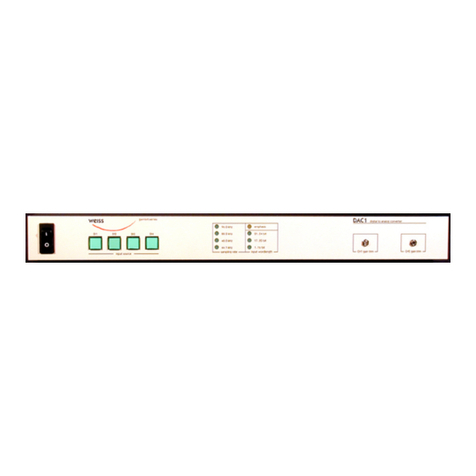
WEISS
WEISS GAMBIT DAC1 User manual

WEISS
WEISS DAC202 User manual

WEISS
WEISS DAC205 User manual
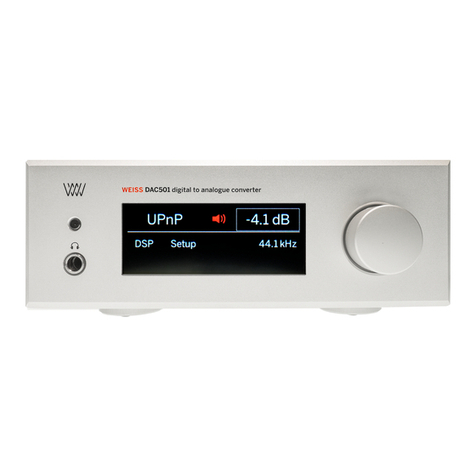
WEISS
WEISS DAC502 User manual
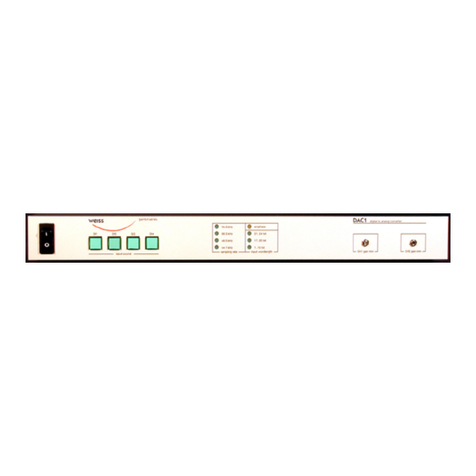
WEISS
WEISS GAMBIT DAC1-MKII User manual
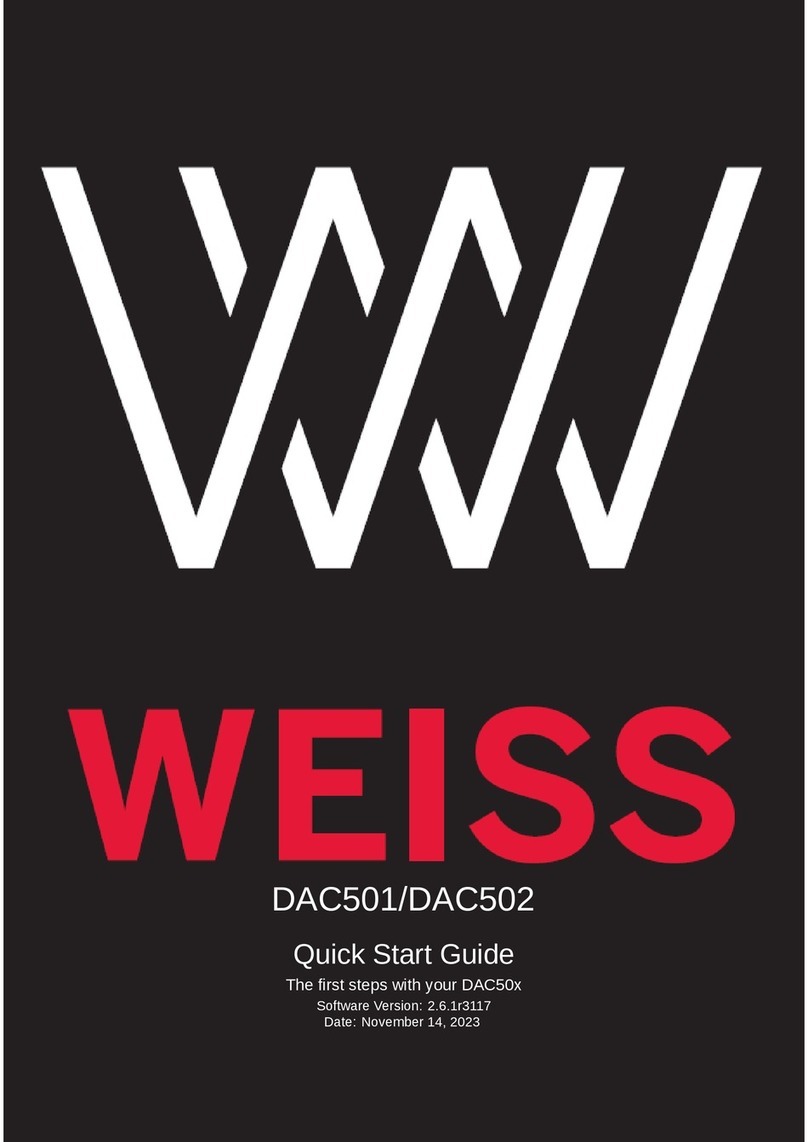
WEISS
WEISS DAC501 User manual

WEISS
WEISS DAC501-4ch User manual
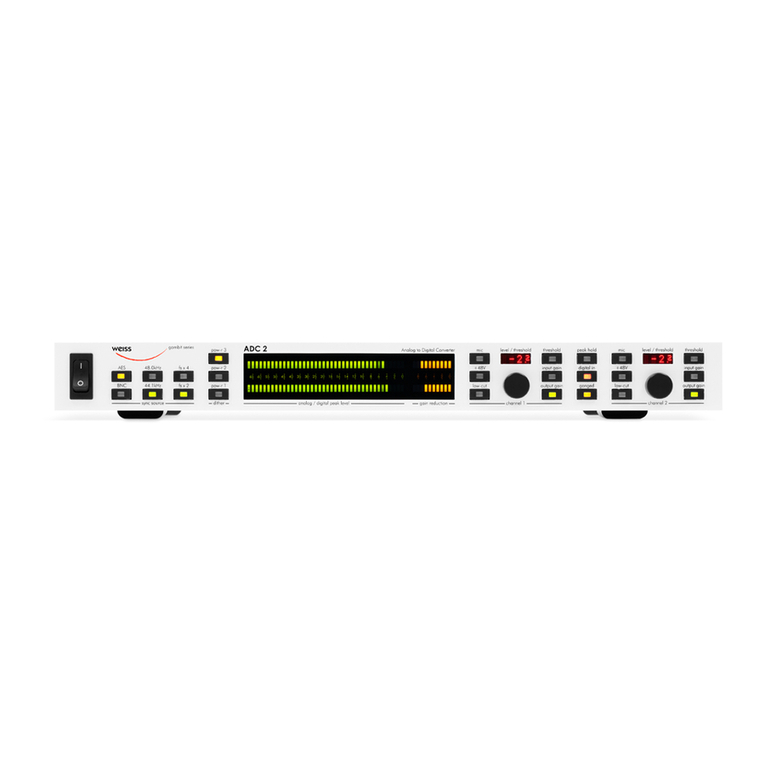
WEISS
WEISS GAMBIT ADC2 User manual

WEISS
WEISS DAC202 User manual
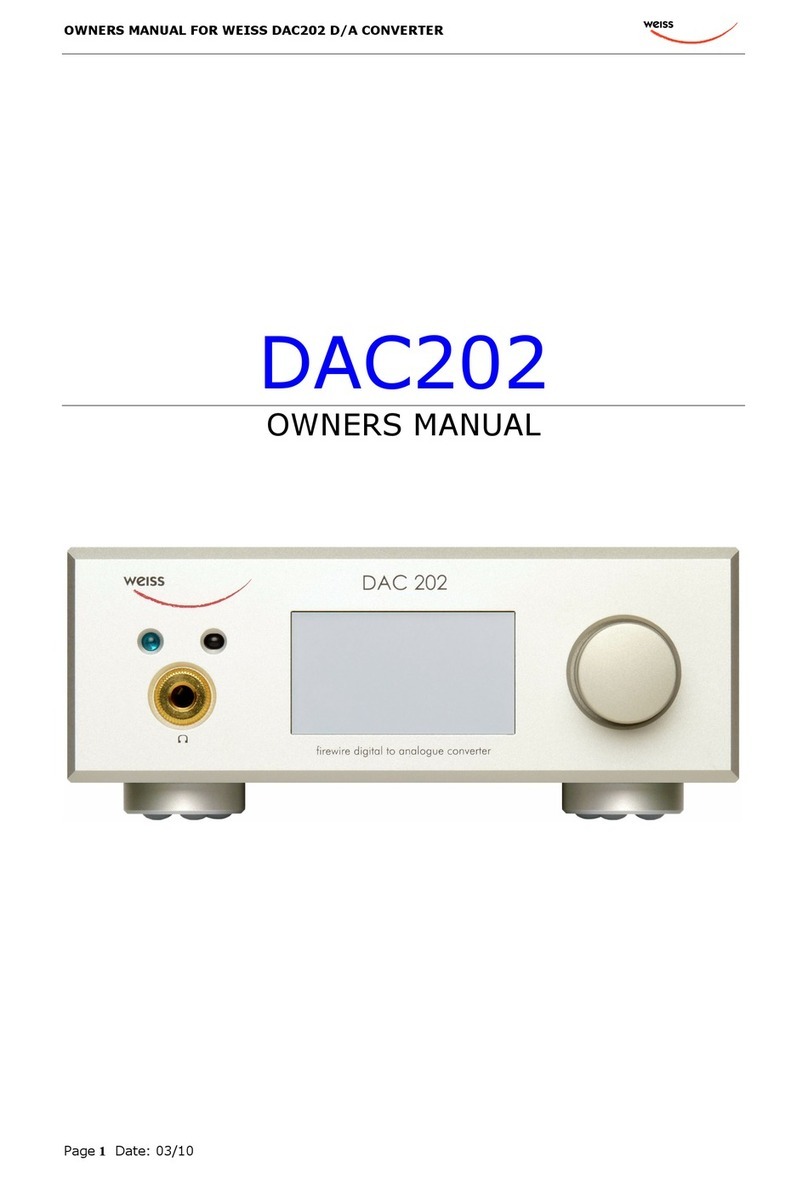
WEISS
WEISS DAC202 User manual
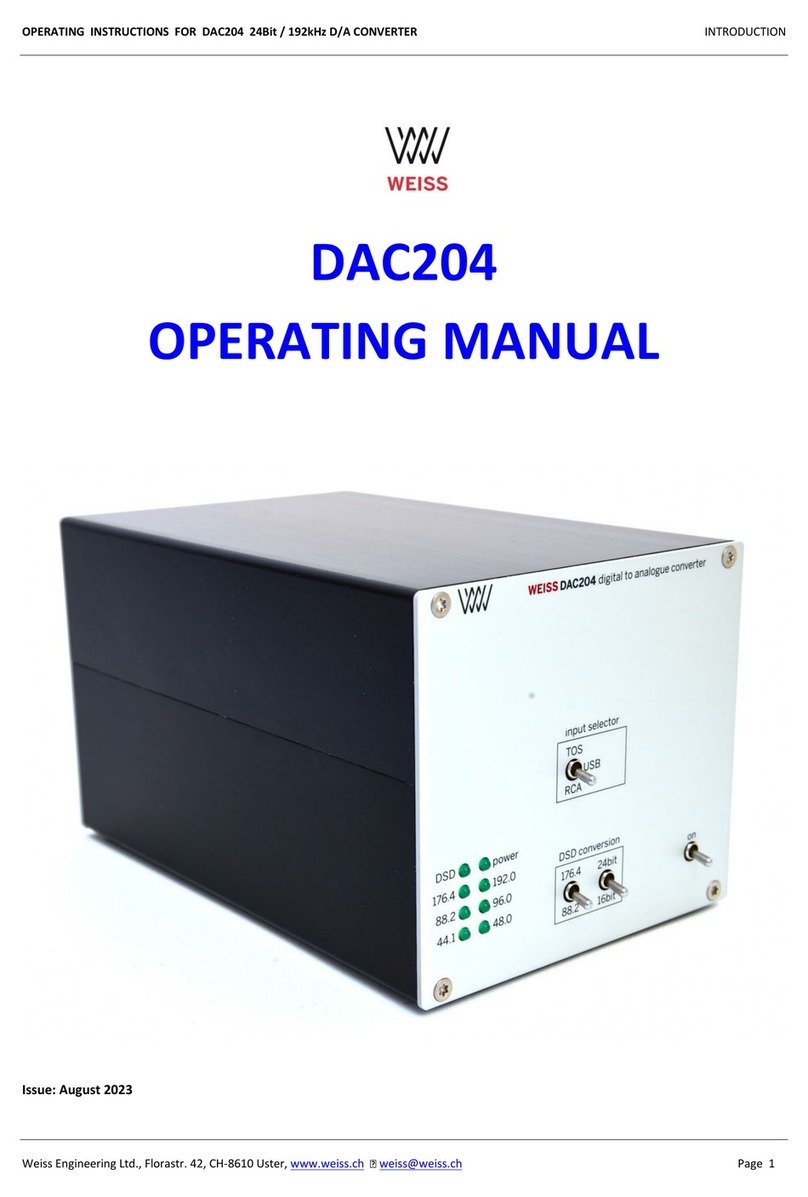
WEISS
WEISS DAC204 User manual
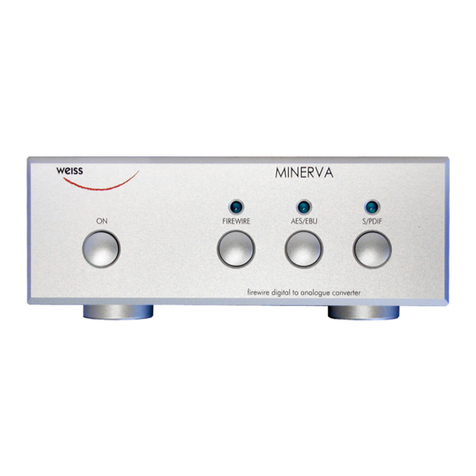
WEISS
WEISS Minerva User manual
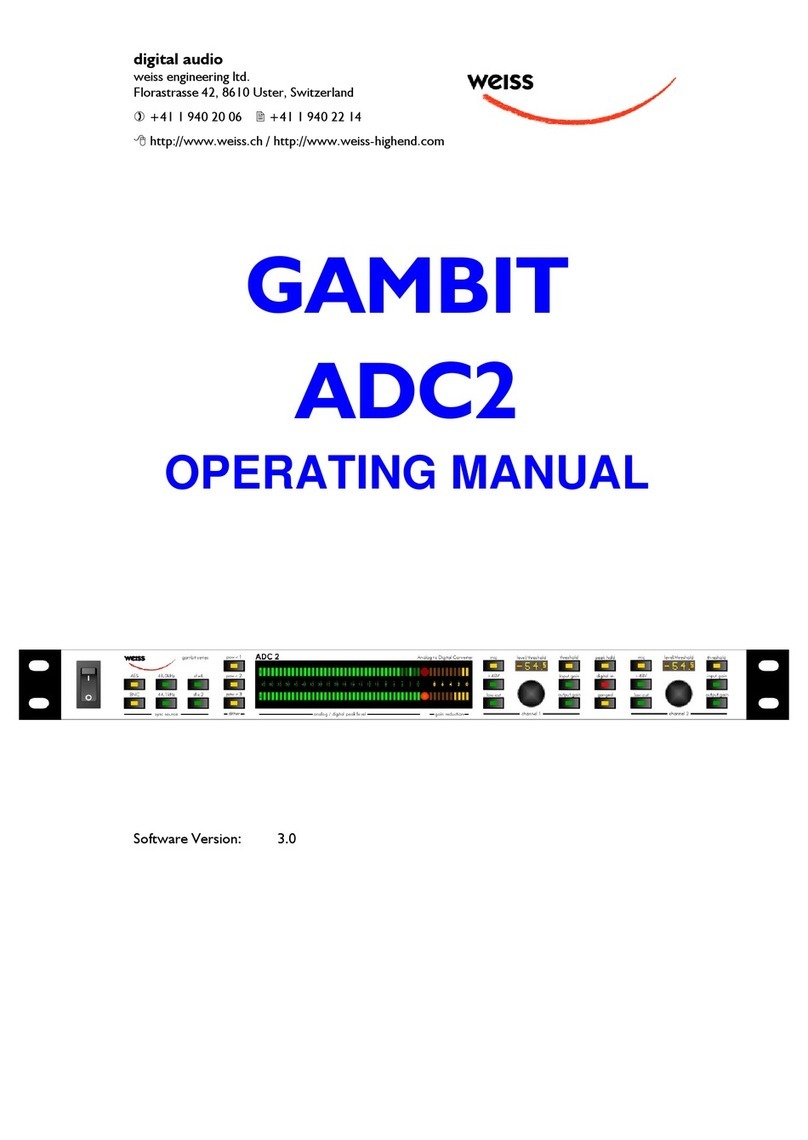
WEISS
WEISS GAMBIT ADC2 User manual

WEISS
WEISS MEDEA User manual
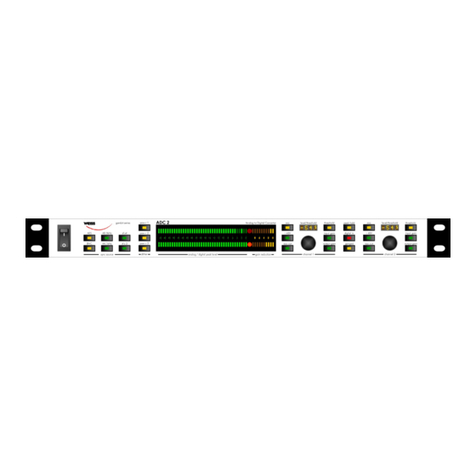
WEISS
WEISS GAMBIT Series User manual
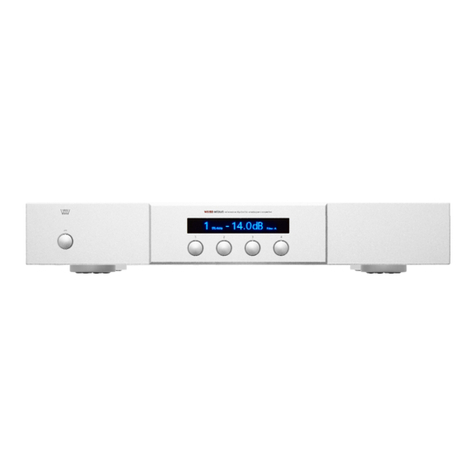
WEISS
WEISS MEDUS User manual
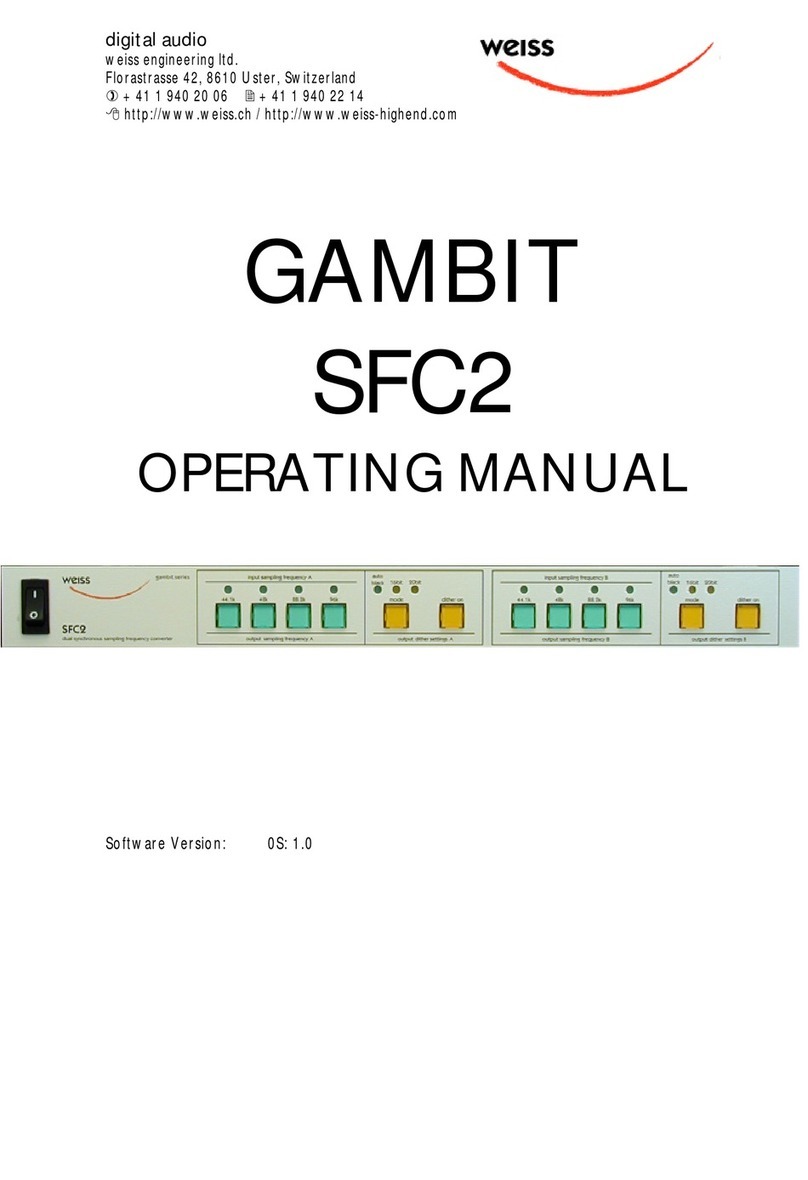
WEISS
WEISS GAMBIT SFC2 User manual
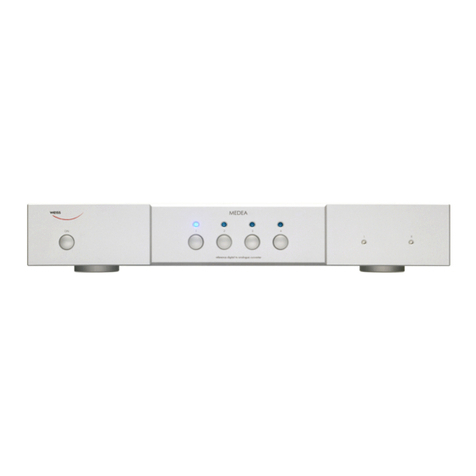
WEISS
WEISS MEDEA User manual
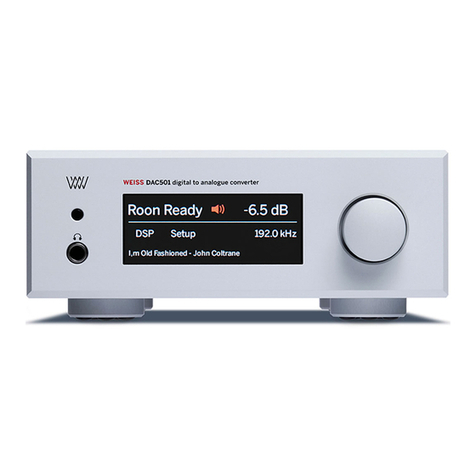
WEISS
WEISS DAC501-4ch User manual

WEISS
WEISS DAC204 User manual
